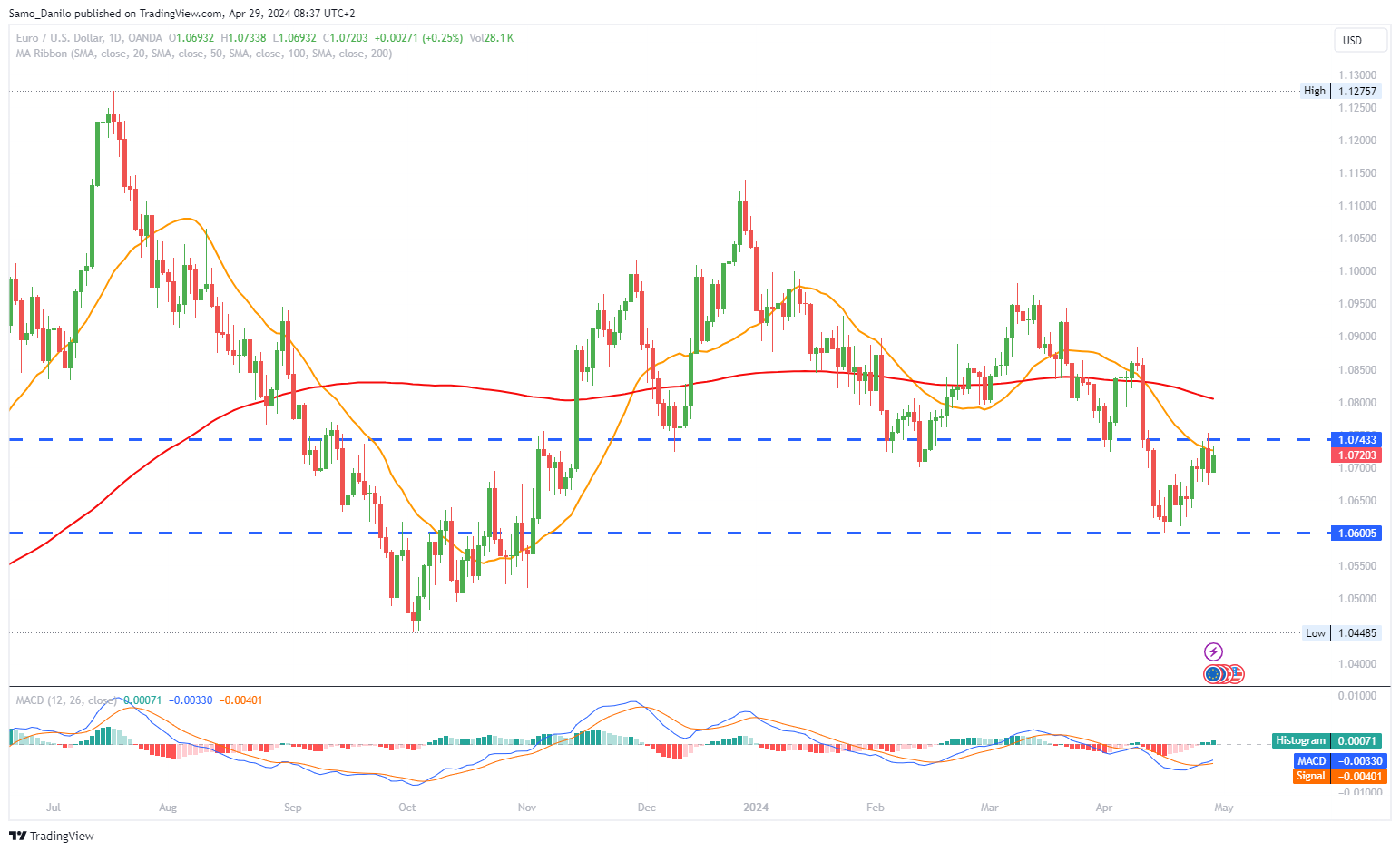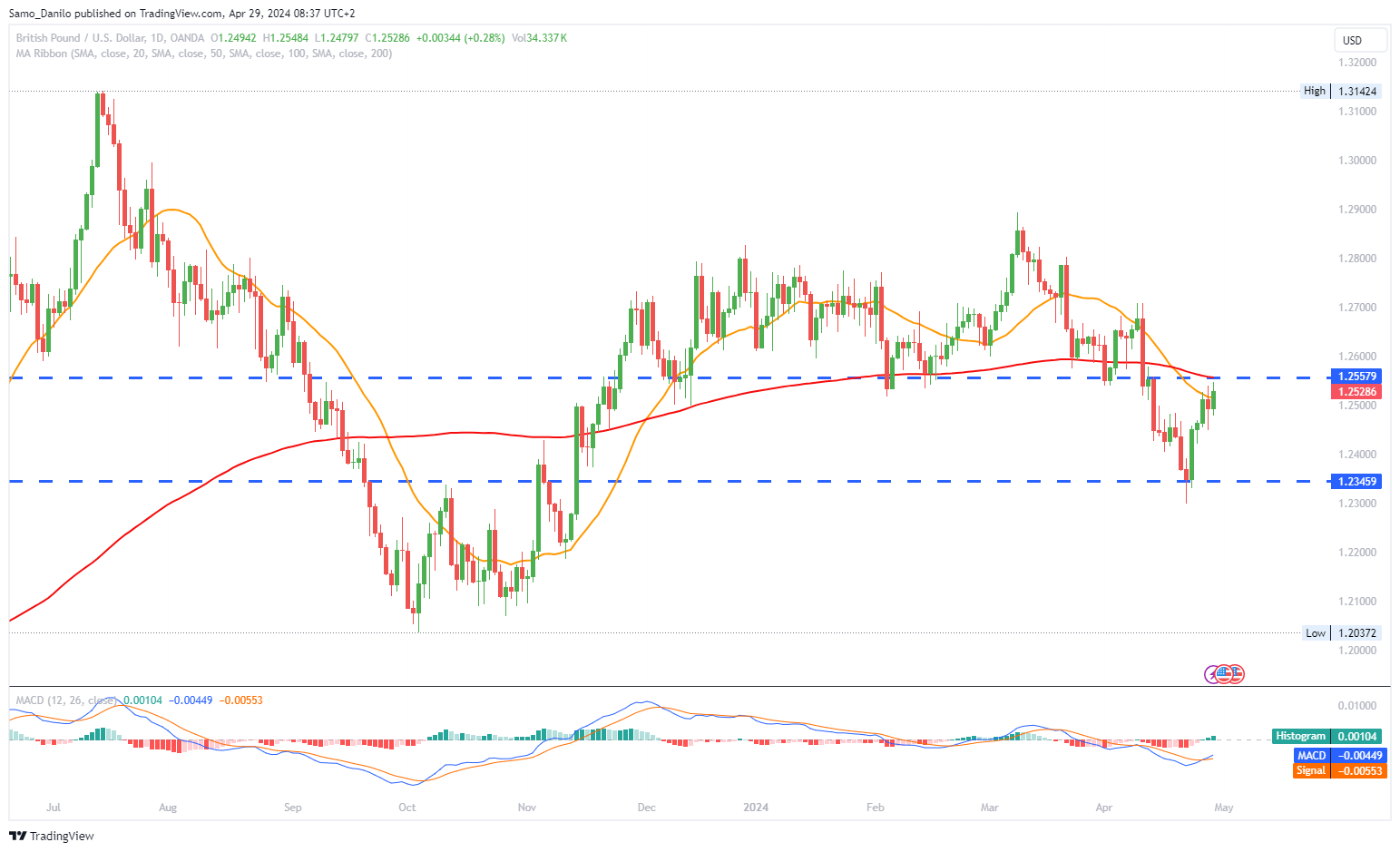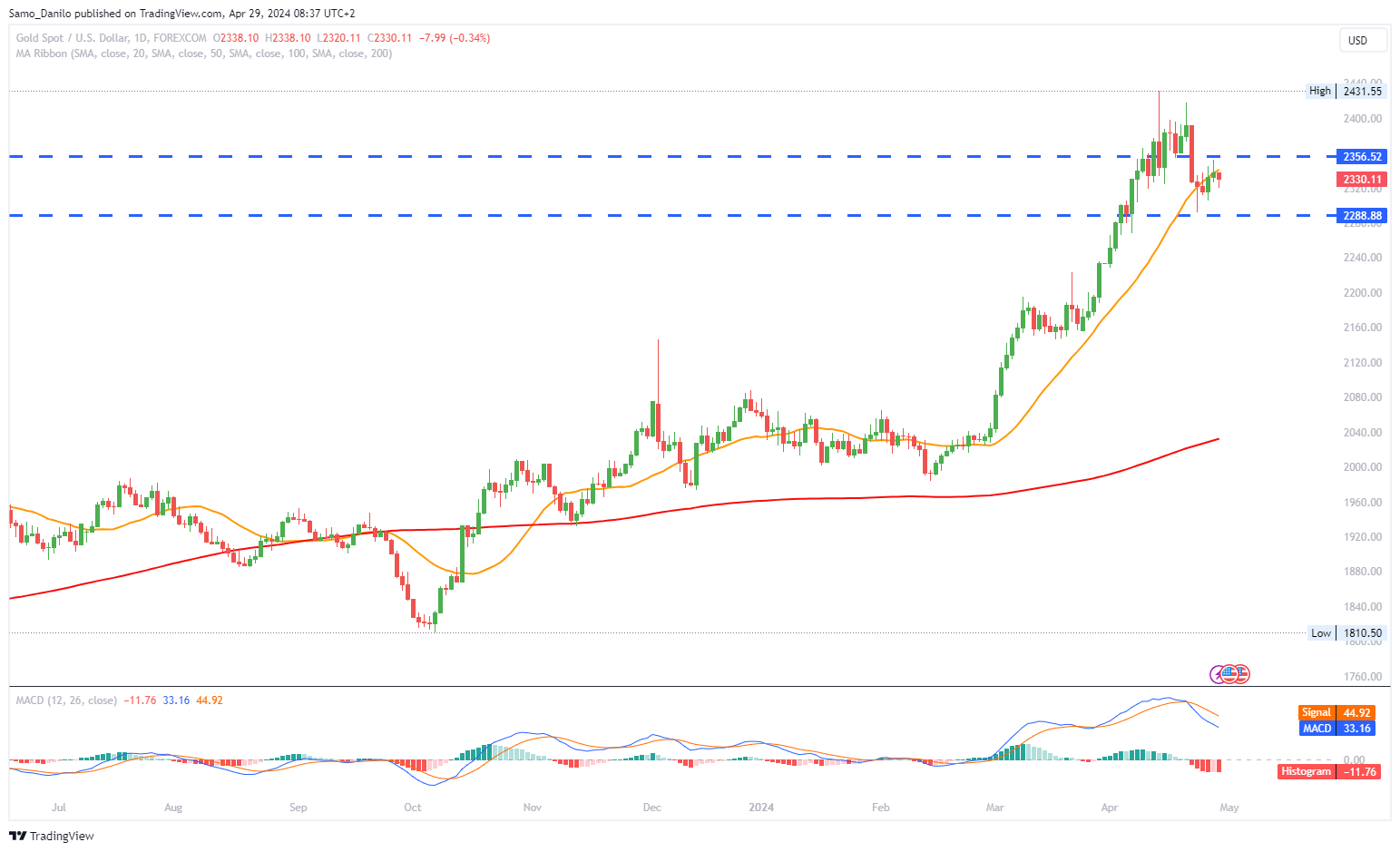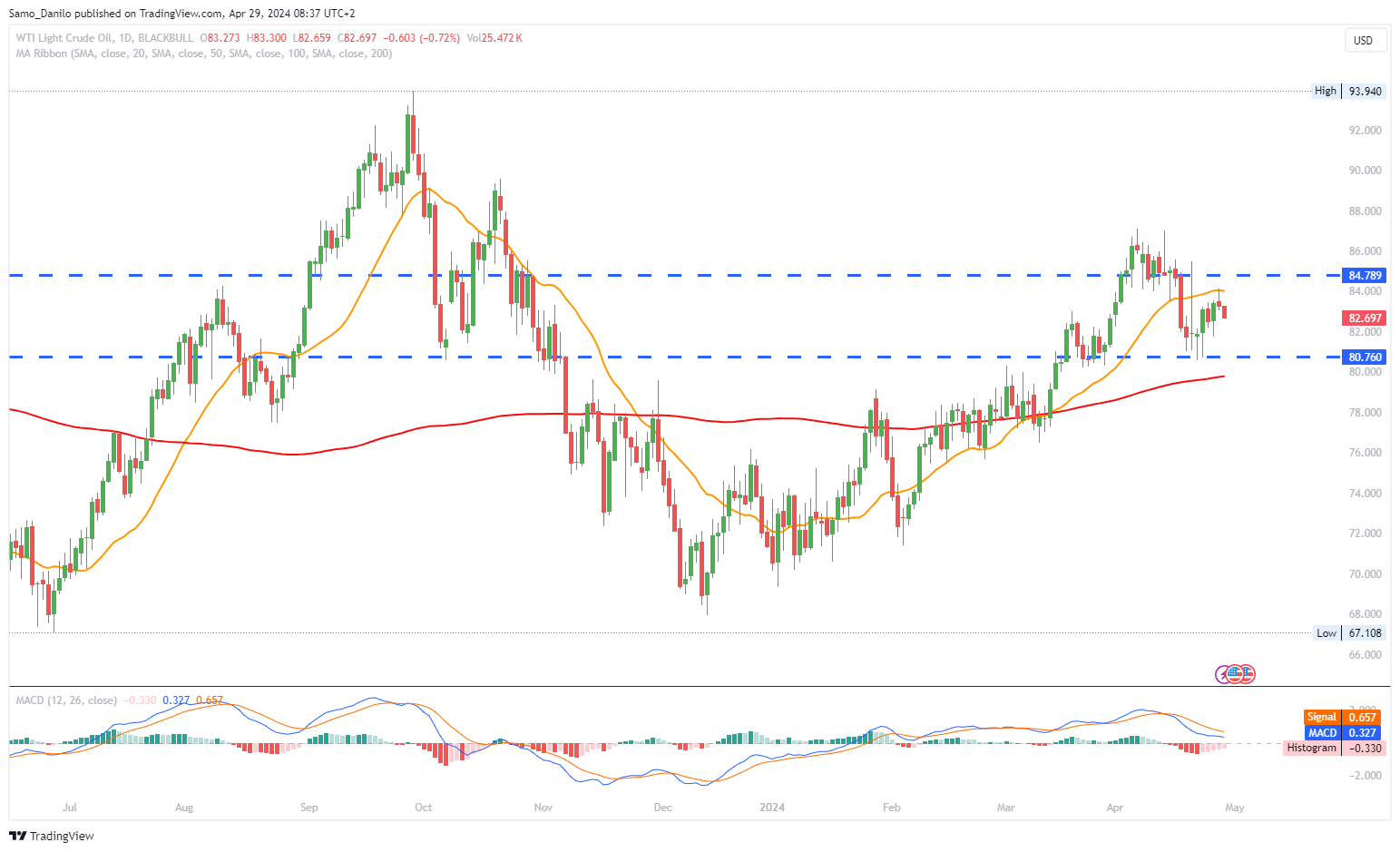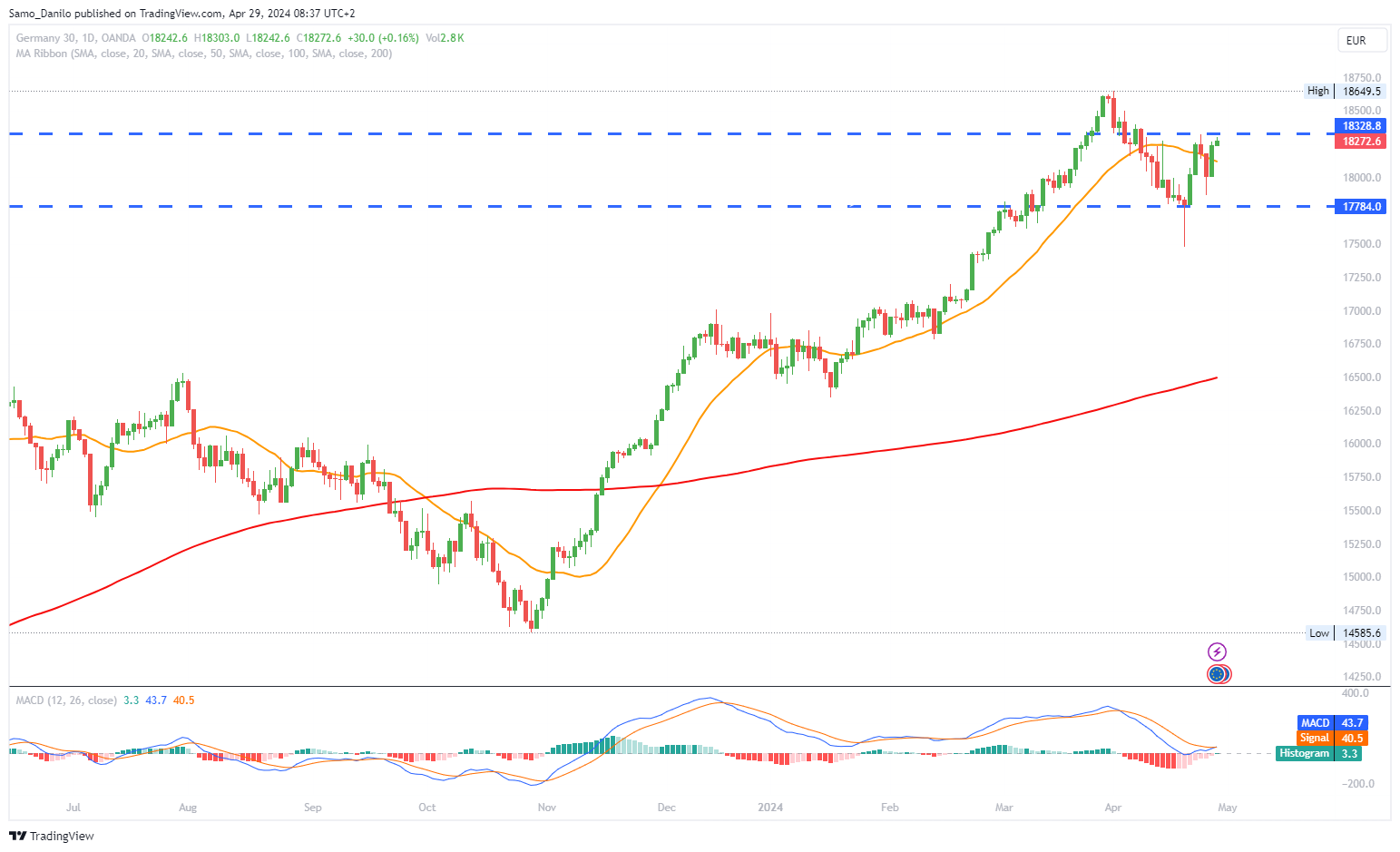EURUSD
- The EUR/USD pair demonstrates strength in early Monday trading, hovering around the 1.0725 level. This upward movement suggests relative strength in the euro against the US dollar at the beginning of the week.
- On Friday, the US Bureau of Economic Analysis released data indicating that the Personal Consumption Expenditures (PCE) Price Index increased by 2.7% year-over-year in March, surpassing both the previous reading of 2.5% and the estimated 2.6%. This higher-than-expected inflation figure may have implications for future monetary policy decisions by the Federal Reserve and could influence currency movements.
- Market participants await the release of the first reading of the German Consumer Price Index (CPI) for April, scheduled for Monday. This data will provide insights into inflationary pressures in the Eurozone's largest economy and may influence the European Central Bank's (ECB) monetary policy decisions.
- ECB President Christine Lagarde has suggested that the central bank is likely to initiate a reduction in its deposit rate from the current record-high of 4% in June. However, she has also emphasized the importance of keeping options open regarding future policy actions, indicating a cautious approach to monetary policy adjustments.
- The upcoming Federal Reserve monetary policy meeting on Wednesday is a key event for market participants. While no change in interest rates is expected, investors will closely scrutinize the Fed's statement and press conference for insights into its future policy trajectory and its assessment of economic conditions.
Closing statement: The EUR/USD pair starts the week on a positive note, supported by expectations of potential ECB policy adjustments and mixed economic data from the US. The release of German CPI data and the upcoming Fed meeting are anticipated to be significant drivers of currency movements in the days ahead.
GBPUSD
- The GBP/USD pair maintains its upward trajectory, trading near the 1.2535 level in early Monday Asian trading. This suggests continued strength in the British pound relative to the US dollar at the start of the week.
- Data released by the US Bureau of Economic Analysis on Friday revealed that the Core Personal Consumption Expenditures (PCE) Price Index increased by 2.8% year-over-year in March. This higher-than-expected inflation figure has led to speculation that the Federal Reserve may delay its first interest rate cut until September, influencing investor sentiment toward the US dollar.
- Conversely, there is growing speculation among investors that the Bank of England (BoE) will commence a cycle of interest rate cuts starting with its June meeting. This expectation is driven by comments from BoE Governor Andrew Bailey, who indicated that two or three rate cuts this year would not be unreasonable during the press conference following the last monetary policy meeting.
- Market participants will closely monitor the Federal Open Market Committee (FOMC) interest rate decision and press conference scheduled for Wednesday. Any insights provided by the Fed regarding its future policy trajectory, economic outlook, and inflation expectations could impact the GBP/USD pair.
| SMA (20) | Falling |
|
|
| RSI (14) | Rising |
|
|
| MACD (12, 26, 9) | Rising |
|
|
Closing statement: The GBP/USD pair continues to trade on a positive note, supported by diverging expectations regarding monetary policy actions by the Bank of England and the Federal Reserve. Investors will closely watch key economic data releases and central bank meetings throughout the week for further guidance on currency movements.
GOLD
- Gold price continues to face resistance around the key 21-day Simple Moving Average (SMA), currently situated at $2,336, as indicated by observations on the daily chart. This suggests ongoing challenges for the precious metal in maintaining upward momentum. Risk sentiment dominated trading in the American session on Friday, contributing to limited upside potential for gold. The prevailing risk-on environment may have reduced demand for safe-haven assets like gold.
- Despite reaching a four-day high of $2,353 on Friday, gold price struggled to sustain gains above the $2,350 level. Market participants considered the impact of robust US Personal Consumption Expenditures (PCE) Price Index inflation data, leading to speculation of a delayed policy pivot by the US Federal Reserve (Fed) later in the year.
- Looking forward, gold traders are expected to exercise caution and avoid significant positions ahead of key events, including the release of US employment data and the Fed interest rate decision scheduled for Wednesday. These events have the potential to influence market sentiment and gold prices.
- While market expectations largely anticipate the Fed to maintain its current policy stance, investors will closely monitor Chair Jerome Powell's comments during the subsequent press conference. Powell's remarks will be pivotal in assessing the timing and potential direction of future rate adjustments by the Fed.
| SMA (20) | Rising |
|
|
| RSI (14) | Falling |
|
|
| MACD (12, 26, 9) | Falling |
|
|
Closing statement: Gold price faces resistance around the 21-day SMA amid prevailing risk sentiment and considerations of robust US inflation data. Traders are exercising caution ahead of key events, including US employment data and the Fed interest rate decision, which could provide further clarity on the future trajectory of gold prices.
CRUDE OIL
- West Texas Intermediate (WTI) US crude oil prices began the new week on a weaker footing, slipping below the $83.10 per barrel threshold during the Asian session. This decline indicates early pressure on crude oil prices.
- Receding concerns about a further escalation of the Israel-Iran conflict have contributed to the downward pressure on oil prices. Additionally, apprehensions regarding higher interest rates in the United States, which could potentially dampen fuel demand in the world's leading consumer, have also weighed on oil prices. The release of the US Personal Consumption Expenditures (PCE) Price Index on Friday reinforced market expectations that the Federal Reserve (Fed) will postpone any interest rate cuts. This expectation has further influenced sentiment in the oil market.
- Over the weekend, Ukraine launched attacks on additional Russian oil refineries. This development occurred following Russia's earlier announcements of export and production cuts, adding to the geopolitical dynamics affecting oil prices.
- Market participants are now awaiting the release of official Purchasing Managers' Index (PMI) data from China on Tuesday. As China is the world's largest oil importer, these PMI figures are anticipated to provide fresh insights and potentially impact oil prices.
| SMA (20) | Rising |
|
|
| RSI (14) | Slightly Falling |
| |
| MACD (12, 26, 9) | Falling |
|
|
Closing statement: In summary, WTI crude oil prices have started the week on a weaker note, influenced by factors such as geopolitical tensions, expectations regarding US interest rates, and developments in major oil-importing countries like China.
DAX
- An ECB report released supported expectations for a rate cut by the European Central Bank (ECB) in June. The ECB Consumer Expectations survey indicated lower inflation and income expectations, suggesting potential downward trends in consumer spending. This report contributed to bullish sentiment regarding a rate cut.
- Additionally, gains in the DAX were fueled by positive reactions to corporate earnings results. Investors responded to earnings reports from tech giants Alphabet (GOOGL) and Microsoft (MSFT), which likely boosted confidence in the market.
- On Friday, investors closely followed the US Personal Income and Expenditures Report. Of particular interest was the US Core Personal Consumption Expenditures (PCE) Price Index, which showed a year-on-year increase of 2.8% in March, matching the previous month's figure. This data influenced market sentiment and expectations regarding US monetary policy.
- Looking ahead, investors will focus on preliminary inflation figures for Germany scheduled for release on Monday. Economists anticipate that the annual inflation rate will rise from 2.2% to 2.3% in April. This data will provide insights into inflationary pressures within the Eurozone's largest economy.
- In addition to economic indicators, investors will monitor ECB commentary for further guidance. ECB Vice President Luis de Guindos is scheduled to speak, and his remarks on the economic outlook, inflation, and the ECB's rate path could impact market sentiment and trading activity in the DAX.
| SMA (20) | Slightly Rising |
| |
| RSI (14) | Rising |
|
|
| MACD (12, 26, 9) | Rising |
|
|
Closing statement: The DAX saw gains fueled by expectations of a June ECB rate cut and positive corporate earnings. Key data releases, including the US Personal Income and Expenditures Report, were monitored. Investors awaited preliminary inflation numbers for Germany. ECB commentary, notably from ECB Vice President Luis de Guindos, also impacted market sentiment.
